|
Monday, April 23, 2012
Progress Notes
A couple of weeks ago I introduced a new feature added to our website which gives the history of the many steamboats which navigated the Osage River. It is a video with a narrative and many photos of steamboats. You can access it from the top of our Home page under the selection Yesterdays following this path (or just click on the link below to go directly to the steamboat site):
Yesterdays > Transportation > Steamboating (video)
The video has been loaned us by one of our website supporters, Wayne Johnson, and will not be a permanent feature so be sure and take a look at it.
One item which you may find of interest is the number and location of the many places along the Osage River where steamboats docked to load and unload goods for commerce. Here is a map which I obtained from Wayne Johnson which locates these sites of landings and gives some information about them:
This week I am going to present the history of the most well known and famous steamboat to have floated the Osage River, the J.R. Wells (photo 01).
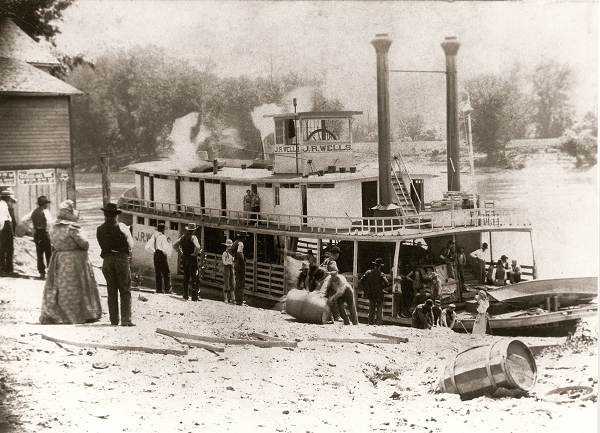
01 J.R. Wells unloading at Tuscumbia
First, I have a newspaper clipping of an article about the history of the J.R. Wells steamboat which had been printed in The Miller County Autogram newspaper. The article, which had been given to the Autogram by Homer Clay Wright, had been written by his father, Clarence Boyce (C.B.) Wright, probably in the early 1940’s.
Unfortunately, the date of publication is not indicated on the copy of the article.
Here is Homer’s introduction to the article:
"The Steamer J, R, Wells was the finest boat to ply the Osage river for any length of time. She was built by Anchor Milling Company in 1898 and sold to operate on the Missouri river in 1919. Here are some excerpts from my dad's writing about the Wells:"
J.R. Wells
by C.B. Wright
(photos 02, 03 and 04)
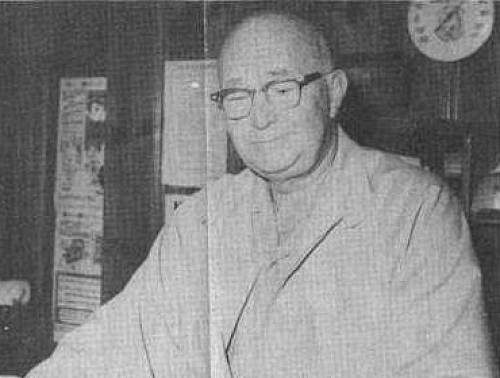
02 Homer Clay Wright
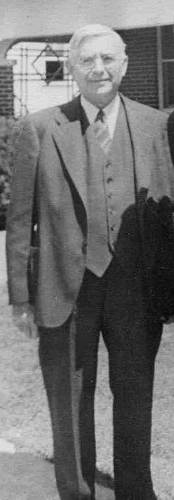
03 Clarence Boyce Wright

04 J.R. Wells and Bat Cave in Bluff
The Anchor Milling Company was incorporated in 1897 with Joshua R. (J.R.) Wells as president and Phillip F. Hauenstein as secretary and treasurer (photos 05 and 06).

05 J.R. Wells
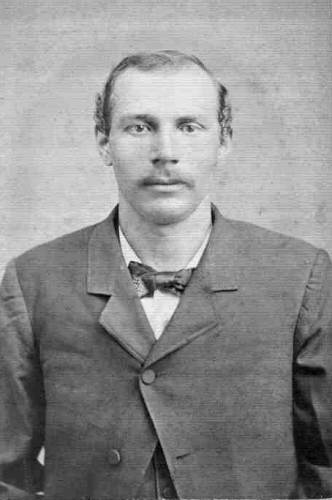
06 Phil Hauenstein
Soon afterward the directors decided that the corporation should have a steam boat since the company had a good flour business at Zebra and Linn Creek. A. J, Watson at Linn Creek was a heavy buyer, his orders averaging 20,000 pounds. The steamboat was built in Tuscumbia by ship carpenter Joe Shepherd of St, Louis who earlier had built the steamboat Frederick. The boat was named "J.R.Wells" after the president of the Anchor Milling Company. The best timber to be had was put into the boat, The hull, except for the bottom, was all oak, The bottom was native pecan, and incidentally, when inspectors checked it years later after the mill had sold her, they found places only three to four inches thick, having worn down two inches or more. The Wells was 20 feet wide and 100 feet long. Her boiler allowed 155 pounds of steam and she was not difficult to fire. The main fuel was wood but a little coal was used. The mill and boat used about 400 cords of wood per year which was purchased for $1.35 per cord. The steamboat was built and got her first inspection in April of 1898. Her first papers were signed by Gordon and Core, United States local inspectors at St. Louis. The Wells was well built; she had good engines 10 x 48, of the slide valve type. The boiler fired well, that is, did not use more fuel than one would expect. A steamboat engineer enjoys seeing the engine perform. A 48-inch stroke means eight foot traveled for each piston for every revolution of the wheel. It was found that the Well's stern wheel was too small and a larger wheel was built in the winter of 1898 which proved just right. John W. Adcock was pilot and master of the Wells, and Darwin Bennett was chief engineer (photo 07).
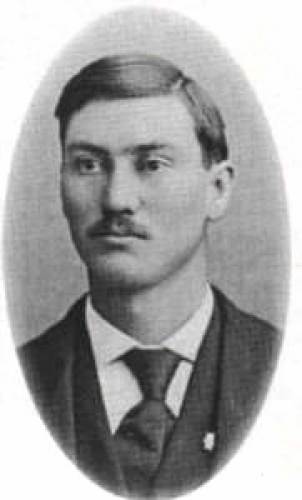
07 John Adcock
Pilots are restricted as to territory and size of boats. All boats are measured in tons. The Wells was rated, when new, at 130 tons but was later re-measured and rated at 100 tons. Engineers are licensed as to tonnage. Large boats have mates and they are also licensed. Henry L. Zibetin of New Haven worked on the Wells as first mate. The duty of a mate is to take charge of the crew and to load the cargo. The idea of building a boat was to better serve our trade; that is, to distribute flour and lumber and bring in lumber and other items for sale in our business and to handle wheat and lumber going out. The J. S. Sullivan Saddle Tree Company was located in the state prison and bought sycamore lumber four to six inches thick and eight to 16 inches wide. A boat load of this lumber would consist of 40,000 to 50,000 feet. On one trip a raft of 30,000 feet was taken out of the water at Zebra.
The author remembers one load of 60,000 feet loaded a quarter of a mile up the Big Tavern Creek. It was wheat that made the bulk of the down river cargo. The Wells made plenty of trips with 2,000 sacks of wheat down the Osage. In 1902, the total amount of wheat handled was a little over 54,000 sacks, all unloaded at Osage City.
Mention has been made of A.J. Watson of Linn Creek. He was in the tie business in a big way and had a large general merchandise store. On one trip to Linn Creek we had a car of salt, car of wagons, car of cultivators and a car of corn planters. He would average a car of wagons a year and bought furniture in car lots. Watson sold Oliver plows and a time or two had straight car loads of plow points. On my first trip on the Wells to Linn Creek we were carrying 200 cases of beer. The last time I saw the Wells was in 1919. Captain Phil and I were on our way to Hermann by rail and saw the Wells tied up in the Gasconade River. Later that day we came back and looked the old boat over. Having been built in 1898 she was then 21 years old. Not long after that the good steamer Wells was cut down by ice some distance above St. Charles at Pelican Bend (photo 08).
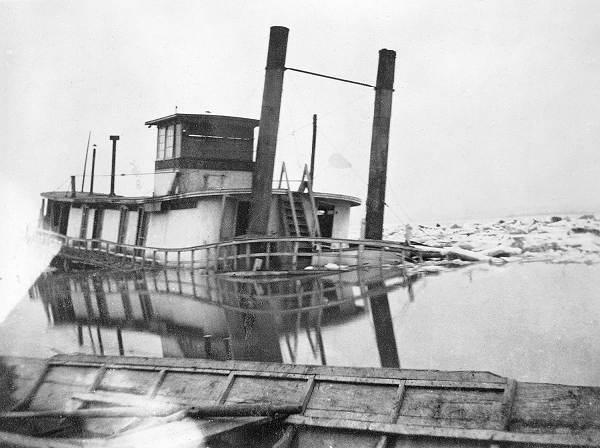
08 J.R. Wells wrecked on Mississippi - W. Johnson
Thanks C.B. and Homer
One of the most complete summaries of the types of loads carried by the J.R. Wells was published in 1976 by an Eldon Advertiser Special Edition which celebrated our country’s bicentennial:
History Recorded in Steamboat’s Osage River Trade
Eldon Advertiser
Special Edition: A bicentennial Salute to Our Country 1976
In the early days of Miller County, the Osage River, the county’s No. 1 stream, was its most important highway of trade, linking it to distant points through the Missouri and Mississippi rivers (photo 09).
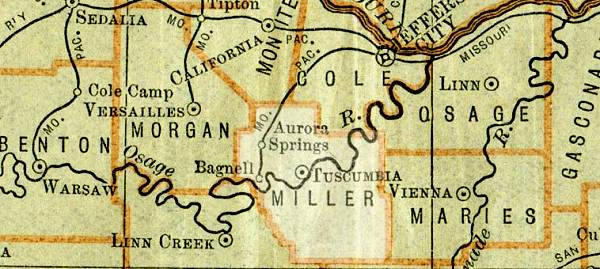
09 Osage River in Miller County
After the turn of the century, railway business had become vigorous, but river commerce still played a key role. It linked the towns, the warehouses, the landings, the individuals along the Osage with the Missouri Pacific and Rock Island railroads which by then had reached into the state’s heartland.
A history of life along the Osage at the turn of the century can be gained from the freight lists of the “coasting trade business” done by Anchor Milling Company’s Steamer J.R. Wells (photo 10).
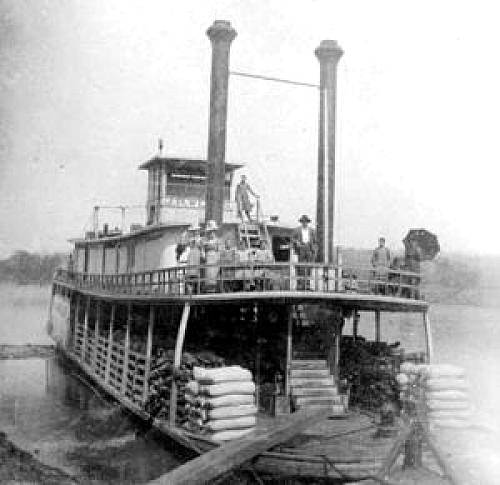
10 J.R. Wells unloading at Tuscumbia
These records, written by C.B. Wright, clerk on the boat most of the time, are still preserved by his son, Homer C. Wright, at Tuscumbia, Anchor Milling manager today.
Note: Since this article was written both men mentioned above are no longer living.
Downstream on the J.R. Wells went eggs, hides, tallow, livestock, poultry, sacks of feathers, timber, ties, clay and other produce, much of it bound for St. Louis. Upstream came clothing, furniture, whiskey, farm implements, coffins, tombstones, coffee, salt, general merchandise bound from Osage City to Irontown above Linn creek, apparently the landing for the Osage Iron Works in the north part of Camden County and south across the river from Purvis (photo 11).
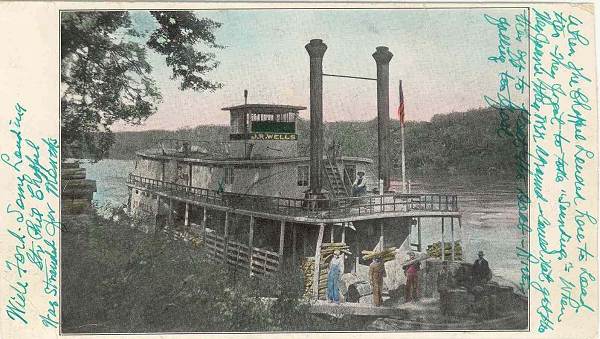
11 J.R. Wells at Wide Ford, C.B. Wright Above
Below are Ben and William Bear, Charley Greenup, Will Nichols and Aaron Wright
Anchor Milling Company sent its own items to customers along the way both upstream and downstream from Tuscumbia.
In those days laundry facilities must have been few and far between. A basket of laundry went back and forth on the steamer from Linn Creek to the Swan Laundry at Jefferson City at a freight charge of 25 cents.
Barges of lumber went from the Tavern and other points to the Sullivan Saddle Tree Company, at Jefferson City. At one time, 36,000 feet of lumber and 230 elm forks headed for the Sullivan Company.
On May 9, 1905, the steamer brought a box of goods, 70 pounds, from the Missouri Pacific at Osage City upriver to the Reverend J. Kramer at Mary’s Home.
As spring farming and gardening time approached, a mower and rake, a cultivator, and a buggy came upstream to Tappehorn landing; 24 boxes of fruit jars went to Pile Brothers at Capps landing; and ten corn planters went to Linn Creek. One gang plow (800 pounds), at a freight charge of $5.12, came to W.S. Goodrich, Tuscumbia.
Ginseng was more plentiful then than now. A bag, weighting 1 ½ pounds, was sent from A.J. Watson, Lin Creek, to St. Louis for 10 cents.
More of the “luxuries” of life began coming into mid Missouri through the years. Oranges, bananas, candy, cigarettes, cigars, telephone batteries, sewer pipe, two boxes of electric goods, an organ, and wallpaper appeared on the freight lists.
And on January 9, 1906, the steamer carried an X-ray machine to Dr. W. F. Byler, weighing 1,255 pounds at a freight charge of $16.05.
The 92 ton stern wheeler, the J.R. Wells, built at Tuscumbia in 1898, approximately 110 feet in length and 20 feet in width and 4 feet in depth, carried large loads on the two deck boat and its barge. Livestock that was moved up and down the Osage was fenced on the barge. On the snowy day of March 9, 1905 John Bunch shipped one car of 96 hogs from Linn Creek to Bagnell (photo 13).
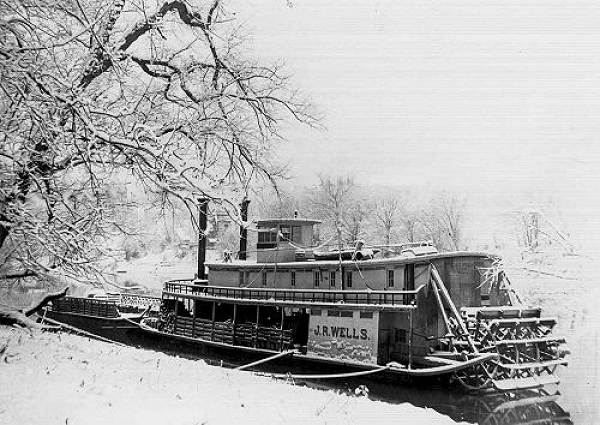
13 J.R. Wells in Snow
One 1908 load shows it was carrying four carloads of cement and one carload of plaster, plus everything else including wood and passengers (photo 14).
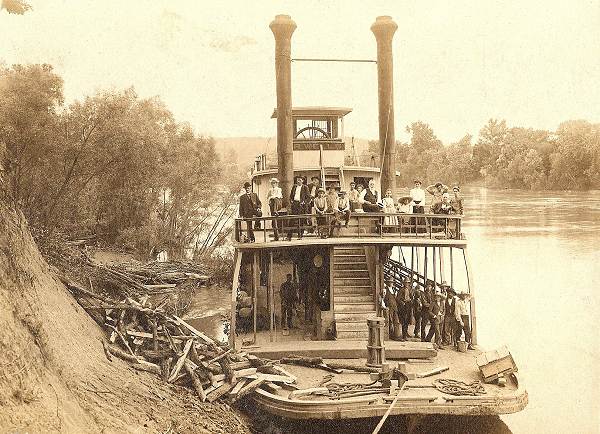
14 J.R. Wells with Passengers - Loading Wood
And the J.R. Wells carried passengers also with its cabins and kitchen on the upper deck along with its staterooms for the pilot, engineer, clerk and cook (photo 15).
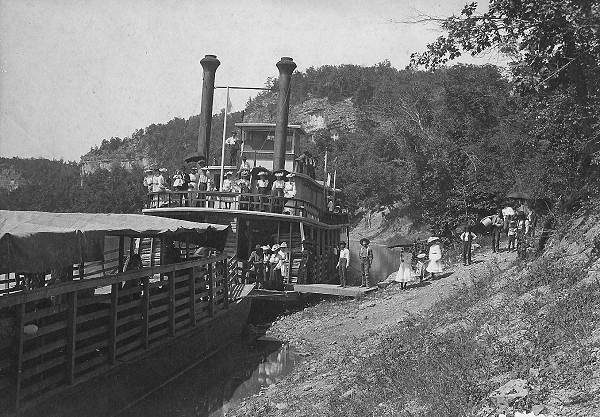
15 J.R. Wells and Barge Schyler's Landing
Some of the passengers were newcomers moving into or going through central Missouri and their possessions brought with them were listed on the payload as “immigrant outfit,” one of which weighed 47,000 pounds (photo 16).
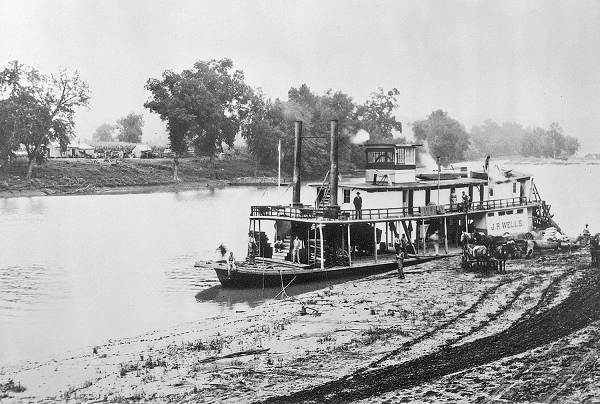
16 J.R. Wells Loading Farm Produce - W. Johnson
In the year 1904, “navigation opened properly March 18 and closed September 10,” the clerk noted in his summary of the J.R. Wells’ coasting trade business. “Represents 24 trips from Tuscumbia to Osage City and Linn Creek. Only four or five trips with Linn Creek left out. The major portion of livestock was unloaded at Bagnell and Hoecker, about 19 cars going to Missouri Pacific and 26 to Rock Island” (photo 17).
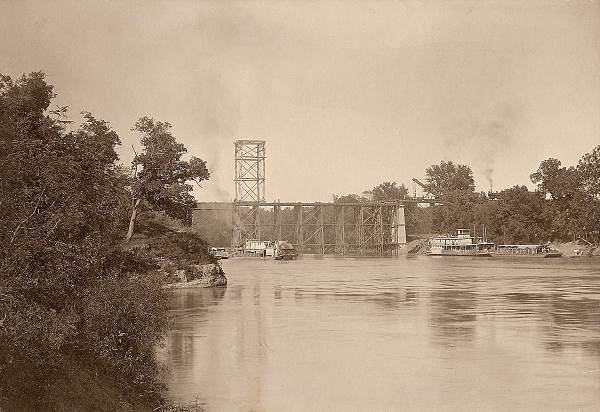
17 Railroad Bridge at Hoecker - J.R. Wells and Peerless
Here are items the Wells carried that year: 5,337 sacks of wheat, 2 tons hay, 305 head of cattle, 1,439 railroad ties, 445 head sheep, 2,587 hogs, 280 gallons wine and whiskey, 956 cases eggs, 134 coops of poultry, 14,122 pounds produce, 215,122 pounds farm machinery, 8,208 pounds bacon, 961 barrels salt, 16,484 pounds iron, 33 barrels oil, 33 tons coal, 128,403 pounds wire, 41,760 feet oak lumber, 20,000 pounds mill machinery, 123,177 feet pine lumber, 1,852 bunches shingles, 34,4060 pounds sewer pipe, 6 barrels lime, 124 barrels cement, 150 brick, 150,000 pounds clay or chalk, 756 sacks corn in ear, 620 bushels shelled corn and 140 passengers (photo 18).
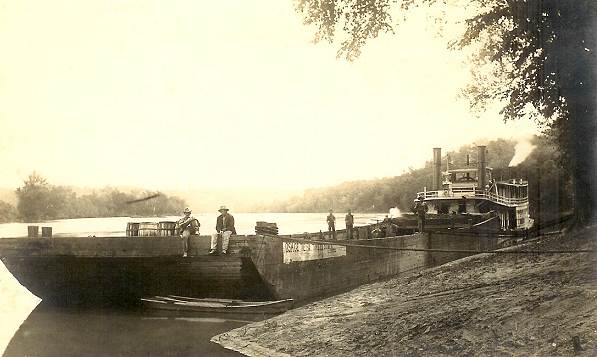
18 J.R. Wells with Barge
Length of the shipping season depended upon the weather and the water and sometimes other factors. In 1905 navigation opened on March 1 and closed October 1 on account of work on the lock and dam downstream from Tuscumbia.
If it hadn’t been for that work on the lock and dam, navigation could have extended into the winter as the clerk noted on February 12, 1906 that “the river up till the present time…has been in fairly good boating stages and has at all times been clear of ice, the mercury so far has hardly been below zero.
On that March 1 opener in 1905, the J.R. Wells carried in its cargo such things as a wagon wheel which George T. Hauenstein, owner of Hauenstein’s Store in Tuscumbia, was sending back to John Deere Plow Company, St. Louis; and eggs, green hides, dry hides, fallow and sacks of feathers which were being sold to F.W. Brockman, St. Louis (photo 19).
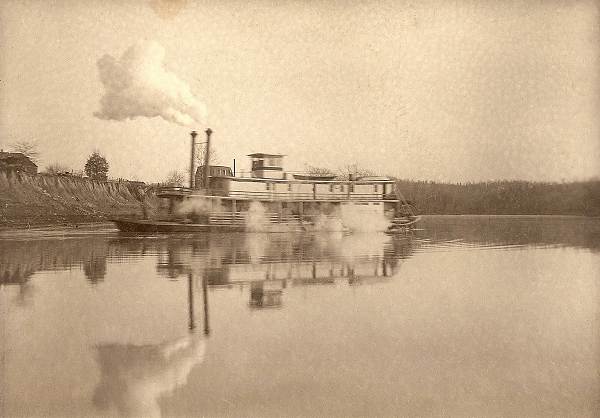
19 J.R. Wells at Tuscumbia
Reed Company, Ulman, was freighting hides and feathers to the city; Anchor Milling Company sent lumber doors, flour and wheat to Twehaus Brothers at Winkelman landing and to Dickneite & Company at Tapperhorn landing. P.P. Richardson shipped wheat to St. Louis. More wheat, eggs and hides were picked up at Capps and more wheat at Boeckman, Schyler’s Ferry (photo 20).
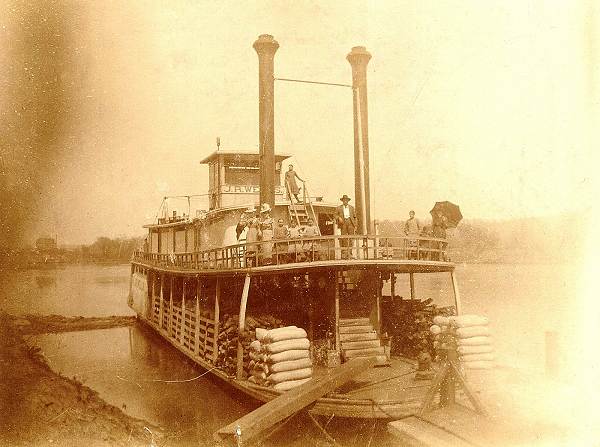
20 Steamer J.R. Wells at Anchor
The total payload on that trip was $104.92. A case of eggs cost 20 cents for shipping from Capps to Osage City.
Going upstream from Osage City and the Missouri Pacific Railroad link on March 5, the J.R. Wells brought a rafting outfit to Schell & Sons, St. Thomas; a case of clothing for H.J. Lueckenhoff, St. Thomas; a john boat and lines for Pile Brothers, nine plows and 17 blade points and three boxes of garden seed for Hauenstein’s Store; nine boxes of wooden coffins for A.J. Watson, Linn Creek; shingles, flooring, nails and windows for ‘Shepherd Brothers, and flour to the town of Zebra (photo 21).
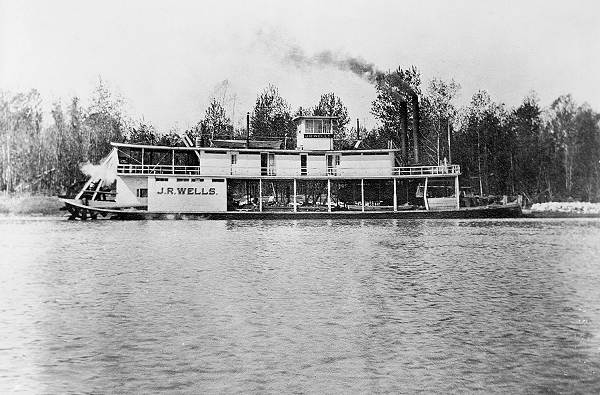
21 J.R. Wells on Osage River - W. Johnson
One boxed organ was going to T.C. DeGraffenreid, Zebra, and numerous items for the A.J. Watson and Hooker & Company stores at Linn Creek. The boat carried a bookcase, brooder and incubator, half a barrel of whiskey, mineral water and drugs, tobacco, spokes and fellers, five sacks of green coffee, saddlery and harness and a case of overalls.
Coming back from Linn Creek on March 9, the steamer carried “household goods and plunder” shipped by W.J. Payne from Linn Creek to Hoecker. On downstream, Tellman Brothers on the Saline shipped 15 cords of handle timber to the Blue Oak Handle Company of Henley.
Stops were many…Linn Creek, Zebra, Bagnell, Tuscumbia, Tellman’s, Blankenship’s, Huhman’s, Capps, Ben Sanning’s, Tappehorn Warehouse, Morman’s, Schyler’s, Mueller’s, Bisgel’s, Feise’s, Castle Rock, Westphalia Landing, Osage City.
In July and August, good water was reported. The J.R. Wells went to Bois Brule and returned to Osage City.
Note: More about Bois Brule can be found in this previous Progress Notes.
Among the summary of the year’s freight for that abbreviated 1905 season were 94 tons of clay or chalk, 442,124 feet of hard and soft lumber (187,436 feet unloaded at Bagnell), 694 saddle tree forks, 179,940 feet of pine lumber, 416 cases of eggs, 723 head of hogs, 60 sheep.
In 1906 the J.R. Wells made 31 trips and navigation continued from January to December, “excepting a few temporary tie ups on account of low water.”
One of these experiences with low water was described in detail by the clerk in his year’s summary:
“Boat and barge…the latter loaded with lumber…were tied up at Lock and Dam No. 1 for a week or two on account of closing of lock gates for repairs. On October 1, boat and barge left Osage City for Linn Creek loaded with two cars of salt and one car of wire and miscellaneous other items.
“By the time they had reached Granny Shoal the river was getting real low and Pilot Clark, attempting to run this shoal in the nighttime, grounded boat and barge. Next morning a line was laid and a short pull pulled both pieces off the bar. Some little time was taken up again getting through the shoal and it was afternoon when the boat reached Bagnell (photo 22).
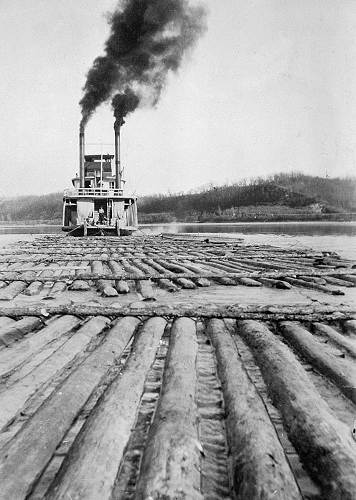
22 J.R. Wells pushing logs - W. Johnson
“More freight was added here and late in the evening, boat cleared for Linn Creek. Reaching Spring Shoal just at night Pilot Clark attempted to run the channel, but stuck the bow of the barge on the south dam. He succeeded in backing off, however, and tied up alongside the rocky bluff. Next morning chute was run in safety and boat proceeded on her way till she reached Zebra.
“The heavy loaded barge being hard to steer, she ran aground on the Zebra side. Tow lines were unloosed and they backed off from the barge, boat running the shoal. Next day, Sunday, over a hundred bales of barb wire unloaded on the bar and the barge pulled off just after nightfall. Boat then went through the shoal and making up tow again, started to Linn Creek.
“Dragged bottom on Corral Draw and stopped at Little Kinselow, after having grounded twice on the north bar directly opposite Anderson’s Apple Orchard.
“A counsel mast then called and the clerk engineer and pilot agreeing that further progress was impossible, and a boat was launched and soundings taken through the gap in Big Kinselow Dam……from 1 ½ to 2 feet was the best water found and it was agreed to turn back and unload at Zebra.
The clerk was sent to Damsel, a telephone station about five miles to the south, where he informed consignees of the facts and they agreed to accept their freight at Zebra.
“Next a.m. the return began…boat safely to Salt Shoal… but again grounded on south side of river. A ‘dead man’ was planted and the anchor taken out and made fast to which a line was laid and boat pulled off with hand capstan.”
It happened that only one man, Louis Hawkey, was left to untie the line and the dam or towhead where anchor was made fast being small, the crew of the steamer decided to christen said towhead or dam “Hawkey Island.” Mr. Hawkey was rescued after a short interval and William Nickle also who had been left on the opposite shore to unfast the snub line (photo 23).
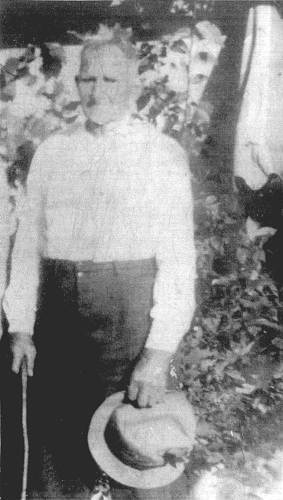
23 Louis Hawken in Later Years
“Boat later proceeded to Zebra and unloaded the whole of her cargo and started the next day again down the river. Some trouble through Glaze Shoal, but only for short time. Boat again grounded in Wideford. Next hang-up was at Hancock.
The steamboats, in addition to their officers and cook, usually had a crew of five to eight deckhands and often hired additional labor to help with loading and unloading.
Another old record book, the “cash book,” dating from 1897 through 1904, tells of receipts and expenses on each trip aboard the J.R. Wells and “on board the good Steamer Dauntless” which was in use a shorter time by the company.
In April, 1897, four upstream trips were made and three down with receipts totaling $967.20 and expenses, $656.20. But not all turned out that well. Sometimes they were in the red. Wages that month totaled $99.35 and hands’ expenses, $79.30.
Among the crew members mentioned during the years were Bill Kay, C.S. Robey, Sam Adcock (photo 24), John Wright (photo 25), D. Bennett, Sam Hawken (photo 26), George Earp, James Spae, Ira Adcock and many others.
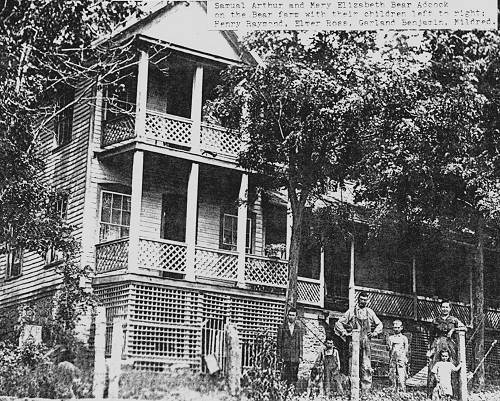
24 Sam Adcock, Lizzie and Children - c. 1914 - At home near the Bear Farm
Click image for larger view
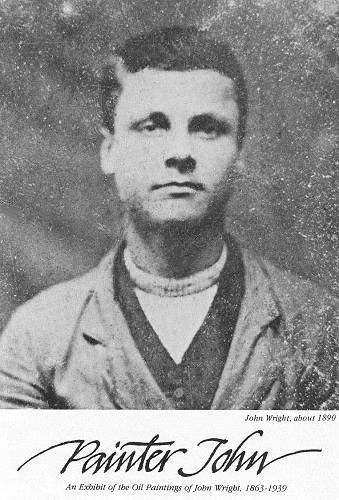
25 John Wright
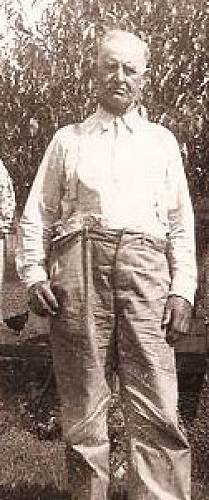
26 Samuel Hawken in Later Years
Fuel was a big item, but the price was right. Eighteen cords of wood were purchased at one time in 1897 for $19.80. A car of coal cost $37.84. Once 130 feet of oak planking for repair of the boat cost $5.
“Grub,” a frequent item, was cheap. Six dozen eggs for $2.50; plums, 15 cents; butter, 3 pounds for 45 cents; two bushel potatoes and seven dozen eggs, $2, and sausage, 50 cents.
There were “extras” too. Once whiskey and lettuce were bought for 75 cents, and beer for the deck hands, 50 cents plus “luxuries” for the deck hands, 95 cents.
September 12, 1902 must have been a special day. Expenses included 91 cents for telegrams. 30 cents for message, and the 75 cents for cigars for the crew.
Railway and warehouse charges and commissions were among the big expenses and settling up of accounts at the end of the year. Not all income was from freight. On one June 11, 1901 trip, 15 passengers were carried for $12.
Excursions were frequent. On August 3, 1900 one to Jefferson City brought in $25 and another to Portland, $40.31, but the tickets cost $1.75 for printing.
Charter money for the barge for a month in 1901 resulted in receipts of $100 and for the Steamer J.R. Wells for 27 ½ days, $412.50. Another time the barge was chartered for three days for $10.00.
“Boat was grounded just as she got near Granny’s landing when it was almost dark. Lines were laid and a messenger was dispatched to a telephone office to call Tuscumbia and have someone bring wire cable used at the lumber yard. Late that evening William Workman arrived with cable. Saturday morning Captain Marshall, who had been sent for, arrived and taking charge, by a series of pulls pulled the boat off the bar just after dark Saturday night (photo 27).
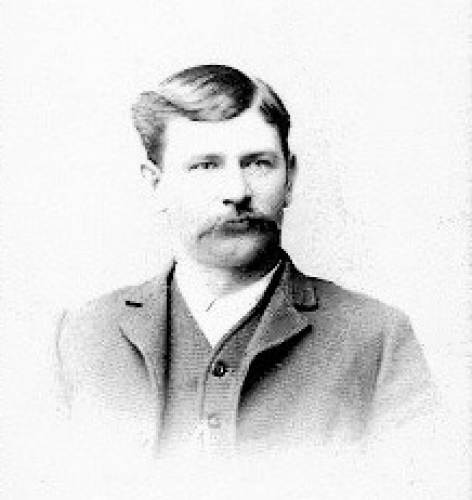
27 Bob Marshall
“Next day the boat again proceeded downriver, grounding and laying a line in Brockman Ford and again grounding in lower end of Brockman, this time getting off without laying a line. In trying to run the Sim Brockman shoal, Captain Marshall, to keep from hitting a fish basket which made a break in the water similar to a stump, landed on the island side where all hands left her but a watchman. She was tied up here for five weeks.”
The summary shows the steamer’s gross earning for 1906 were $6,506.81 as it travelled 4,410 miles. It paid the railroads $2,242.13 for freight handled overland. The boat handled 2,936 tons of freight during the year of gross earnings of $2.21 2/3 per ton.
In 1908 the J.R. Wells not only handled freight along the Osage but also down the Missouri to St. Louis (photo 28).
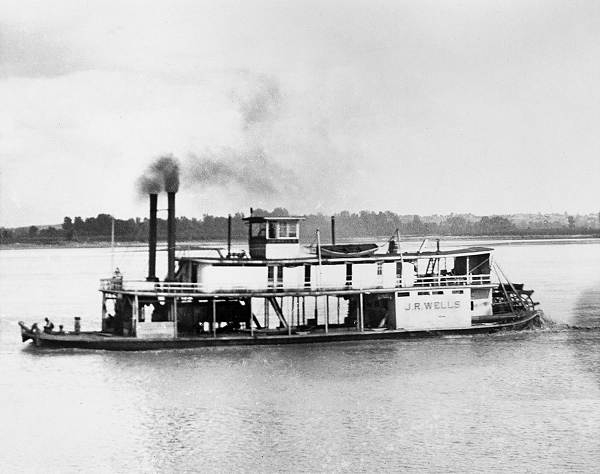
28 J.R. Wells on Missouri River - W. Johnson
On one trip from St. Louis, from which it departed June 6, it carried freight consigned for Washington, New Haven, Hermann, Portland, Chamois, Bonnots Mill, lock on the Osage River, Westphalia, Osage Bend, Haselhorst Landing, St. Elizabeth, Capps, J.B. Tellman landing, Tuscumbia, Bagnell, Zebra and Linn Creek, starting back from Linn Creek June 14.
Note: Here are some other photos of the J.R. Wells on the Missouri River from the files of Wayne Johnson (photos 29, 30 and 31):
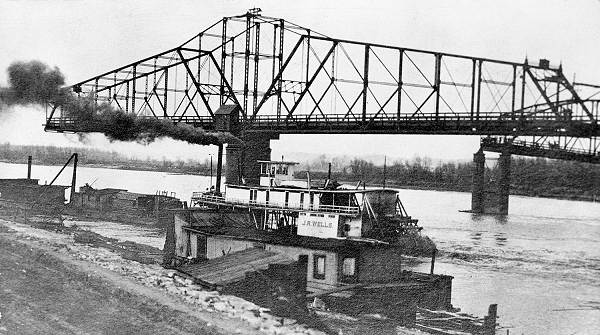
29 J.R. Wells at Jefferson City Ferry Landing - W. Johnson
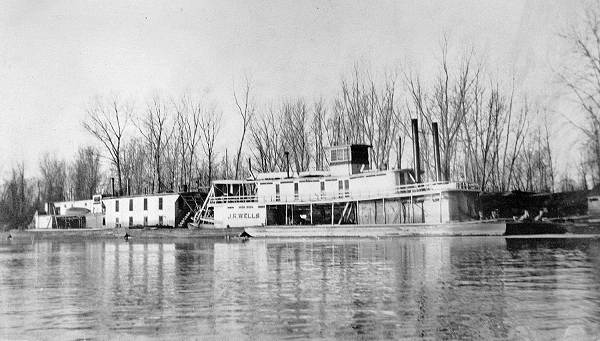
30 J.R. Wells on Missoui River - W. Johnson
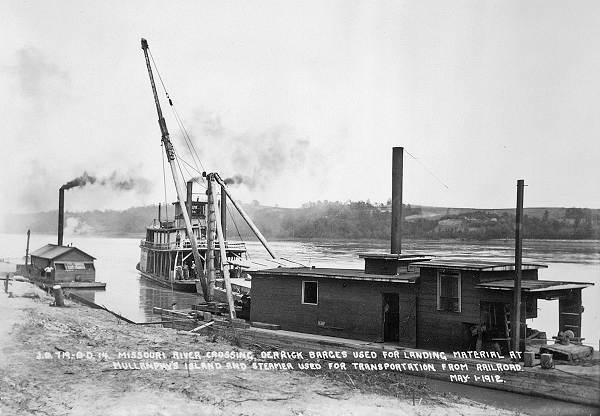
31 J.R. Wells on Missouri River - W. Johnson
John Adcock and James Clark were pilots of the J.R. Wells almost exclusively during the time it was owned by Anchor Milling Company (photos 32 and 33).
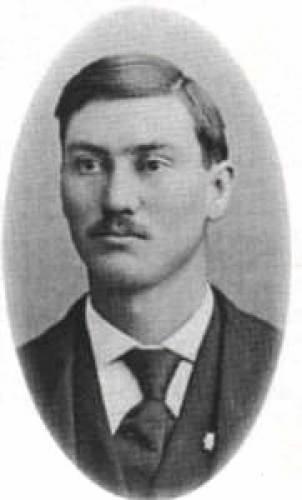
32 John Adcock
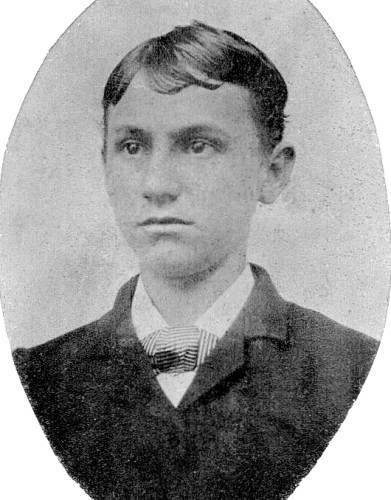
33 James Clark
Here is a photo of John at the wheel of the J.R. Wells (photo 34):
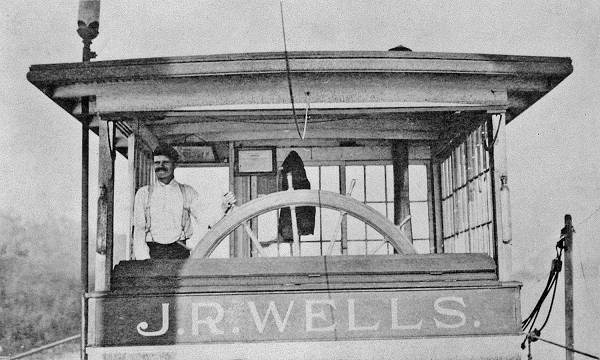
34 John Adcock, J.R. Wells Captain - W. Johnson
John’s brother, Sam Adcock, also worked on the boat (see photo 24 above of Sam).
A very fascinating history of John Adcock was sent me by Tarney Smith, whose husband, Phillip Harvey Smith, was a grandson of Sam Adcock, brother to John Adcock. You can read it here (photo 35):
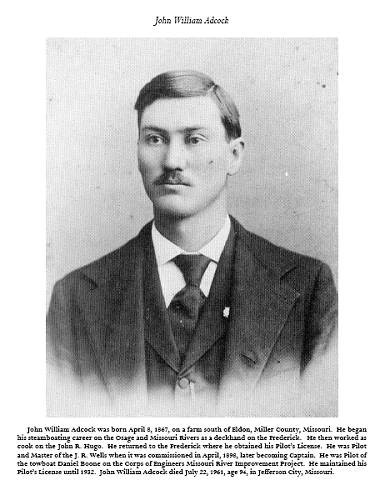
35 John William Adcock
Click image to read entire document in PDF format
You can read more about John Adcock at this previous Progress Notes.
And you can read the very interesting history of James Clark at this previous Progress Notes.
For a very complete history of J.R. Wells himself, the man for whom the J.R. Wells steamboat was named, go to this previous Progress Notes.
When you visit our museum don’t fail to see the model of the J.R. Wells made by Braxton Wallace (photo 35a).
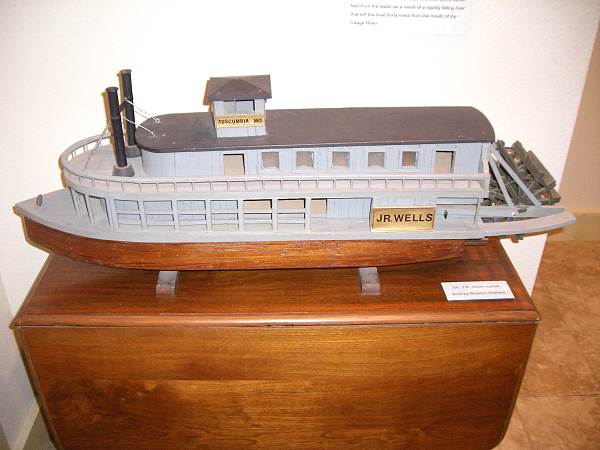
35a J.R. Wells Model in Museum
It is located in the lower level of the new addition where the steamboat display is located.
Ellis Bray of Eldon composed an original song about the J.R. Wells which he sang at one of our MCHS meetings on October 15, 2007. He was accompanied by Leo Barnhart, Joe Jeffries and Eddie Cotton (photo 35b):
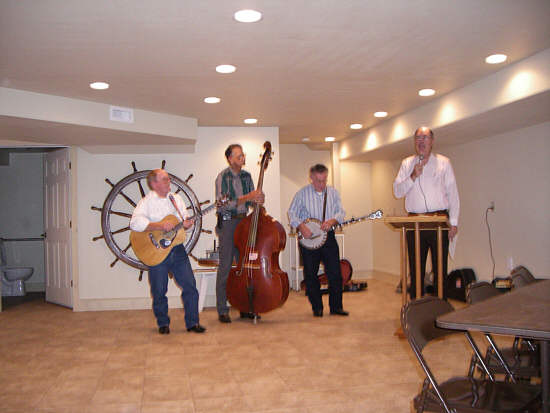
35b Ellis Bray with Musicians Leo Barnhart, Joe Jeffries and Eddie Cotten
Here are the lyrics to that song:
The Ballad of the J. R. Wells
Chorus:
Steamboat's a'comin! I bet it's the J. R. Wells.
There's a couple of bends between us, so I can't rightly tell,
Let's go down to the woodyard to see if she stops by.
See the smoke and steam; hear that whistle scream.
It's the J. R. Wells. Oh, my!
(instrumental interlude - repeat of last line)
Verse 1:
Out of oak and elm and a big fine boiler, they built the J. R. Wells;
Right on the banks of the Osage River, below Tuscumbia's hill.
They built her to be a workhorse, and on her they'd depend.
They built her to float on a foot 0' water, 'round the river's crookedest bend.
(Chorus, then interlude)
Verse 2:
With tiff and lead, and with grain and lumber,
With venison, pork and furs,
They'd load up the Wells to steam down-river,
Through a hundred miles of curves,
Down past the mouth of the Osage, [and] on to the Mighty Mo.
With salt and nails, with plunder and mail, she'd be back in a week or so.
(Chorus, then interlude)
From Warsaw to Linn Creek and Devil's Elbow,
From Zebra to Shipley Shoal; From Bagnell on down to Osage City,
The J. R. Wells would roll,
Headin' for the Big Muddy, the captain' d push his boat,
Sayin', "Open up the channel, boys, gotta keep the Wells afloat!"
(Chorus, then interlude)
Coda:
Steamboat's a'comin'! It's the J. R. Wells. Oh, my!
©E.M.Bray, 2006
Another item of interest contained in the 1976 Eldon Advertiser sesquicentennial Memorial was this short article about phone service many years ago:
‘Horse Sense’ included in 1911 Advice to Phone Trouble Shooters’
Eldon Advertiser Bicentennial Edition 1976 (photo 36)
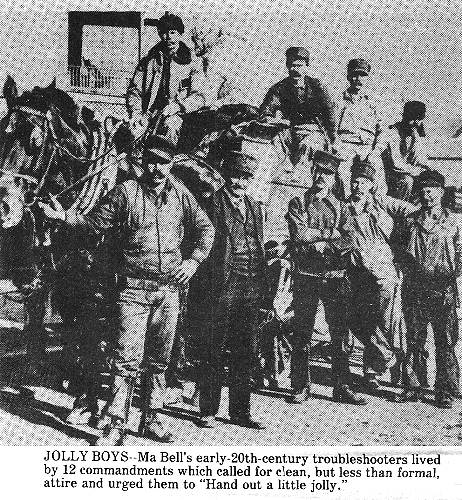
36 Early 20th Century Bell Telephone Troubleshooters
In the early days of the telephone business, phone company trouble shooters were instructed to live by 11 commandments for neatness and public acceptance that began with some good horse sense. In 1911, it read:
1. “Treat everybody as you like to be treated, not forgetting your horse. If you want to know the horse’s side of it, just take off your coat and hat some day, hitch yourself to the same post with your belt, and stand there about two hours. Hereafter, don’t forget his blanket.
2. “Put up a ‘good front.’ It is not necessary to advertise any tailor shop, neither is it necessary to go about your work looking like a coal heaver. Overalls can look as respectable as anything else, but they must at least show that they are on speaking terms with the laundryman; and your shoes must have a bowing acquaintance with the bootblack.
3. “Make the liveryman wash and oil your wagon and harness, and to not tie the harness up with wire longer than is necessary to get proper repairs. The same may be said of you suspenders and buttons.
4. “Don’t pitch dry batteries into the bed of your wagon to be hauled around day after day with broken glass, bolts, wire, pole steps and what not. Don’t neglect to memorize the fact that the supply houses are not running charitable institutions for the benefit of the company.
5. “Go about you business cheerfully and quietly. When you enter a residence, don’t overlook the foot mat. If requested to go around to the back door, don’t consider yourself insulted, but try to realize that the lady of the house may not have a maid, and is only trying to save work for herself. Say ‘good morning’ or ‘evening.’ It doesn’t cost anything and shows you started out right at home.
6. “If compelled to do anything that makes litter, ask for a newspaper to catch the trash. The lady of the house will be grateful.
7. “Close the door when you go out, not forgetting to shut the front gate.
8. “When you leave be sure to have looked over everything carefully and have anticipated, as far as possible, some future trouble.
9. “It is not necessary to tell the lady of the house that her telephone is worn out and not good. She may think so much herself. Tell her that her telephone is as good as anybody’s and back it up by making it so.
10. “If you ever believe that a subscriber is a crank, forget it. All of them are wise enough to tell when a telephone is not working right. Not every trouble man can to this.
11. “Be courteous and polite and don’t be afraid to hand out a little jolly occasionally. It doesn’t hurt anybody’s feeling to be jollied a little.”
Once in a while events in Miller County occur which strike the interest of newspapers far away. One instance of this occurred during the time the old Miller County courthouse was being constructed on the hill overlooking the Osage River in 1910-1911. Somehow the Kansas City Star learned of the construction project and found the details so interesting that a reporter from the paper was sent to write an article about the new courthouse construction which was printed in the Star. Later the Star article was reprinted in the Miller County Autogram Sentinel. I have an Autogram clipping of this article which was a reprint of the original Autogram article printed in 1911. The reprint was published in the “History in Review’ column, probably sometime in the 1950’s or later.
Miller County Autogram
March 2, 1911
A Technicality That Build a Courthouse
Copied from the Kansas City Star
Five out of six of the voters of Miller County, Missouri, made no effort to conceal their mirth on the night of the bond election in December, 1909. It was a great joke on Tuscumbia, the county seat. The proposition to issue bonds for $30,000 for a new courthouse had been defeated. Fine! Miller County could now lie down to pleasant dreams.
Of course, few voters denied that a new court house was needed. The old building, erected in 1857, was shaking with age (photo 37).
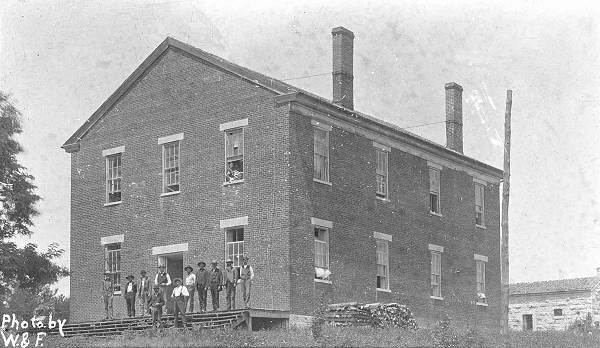
37 Old 1857 Courthouse
The county records were housed in wooden closets. But one of these ancient controversies, a county seat fight, had been a factor in the bond election with Iberia to the south and Eldon to the northeast, aspirants to the county capital. Assembling their forces, they caused a proposal to expend $30,000 for a new courthouse in the rival town of Tuscumbia to appear decidedly “scattering” in the returns.
If the boosters from Iberia and Eldon had reasoned one little detail, they might have been laughing yet. The consideration overlooked was the fact that two of the county judges chosen to sit in judgment in the affairs of Miller County were residents of Tuscumbia. They were David C. Bear, Presiding Judge, and J.L. Blackburn, judge from the northern district (photos 38 and 39).
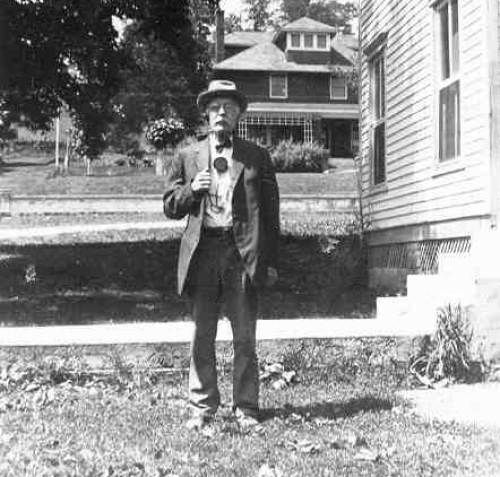
38 David Christian Bear

39 John L. Blackburn
After the election the county judges settled down to the humdrum routine of transacting the county’s business. The procedure wasn’t quite as hum drum as the county judges could wish, however. For example, when a county judge is placing his O.K. on a county bill or affixing his signature to a voucher, it is rather disconcerting to have the ceiling begin to fall down on him! Little incidents of this sort are also a stimulus to the imagination.
Along in the spring of 1910 the county judges began to accumulate “nerve.”
One day when a particularly large section of ceiling had splashed down on the long table at which the judges sat, one of the judges conceived an idea. Why not “repair” the old courthouse? That is, why not “repair” it by building a new courthouse? Of course, under a technical interpretation of their powers, the judges understood they could not appropriate money to build a new courthouse. Bonds must be voted by the people under such circumstances.
The judges concluded that for once, at least, the technicality should be invoked on behalf of progress.
And so, on April 9, 1910, the judges voted to “repair” the old courthouse. J.J. Alexander, the third judge, did not live in Tuscumbia, but desiring very much to live somewhere, voted with the Tuscumbia judges and the order was unanimous.
To keep within the law, the judges then issued, in effect, an order to “repair” the old courthouse, by building a new house entirely around the old one. The first contract, let for the stone work and the building of five concrete fireproof vaults, called for an expenditure of $13,800. This was money that had accumulated in the county treasury for years, through a very economical expenditure of funds.
Since the original contract was let, a new board of county judges has gone on with the work of construction and is now completing the dome of the building, making the complete cost to date, $14,675.50, which has exhausted all available funds of the county and involved it in debt of nearly $1,000.
The new courthouse is a handsome affair. In dimensions it is 50 by 112, completely enveloping the old courthouse, which is 42 by 56. There were eight rooms in the old building. When the new building is completed, it will have twenty rooms.
Note: Here is an old photo of the 1910 courthouse the first day it was opened after construction (photo 40):
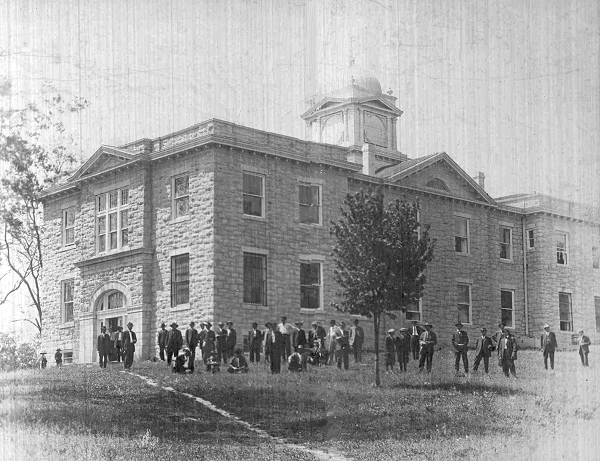
40 Opening of Remodeled Courthouse - 1910
It will take four years to accumulate funds necessary to complete the courthouse, say the judges, and it has made necessary a most rigid system of saving in every department, excepting maintenance of the schools.
Tuscumbia has been the seat of Miller County ever since the state legislature in 1837 chopped off the edges of Cole and Pulaski counties and established Miller County.
Miller County is in the foothills of the Ozarks. To appreciate the true altitude of Tuscumbia, one should know that chickens from back yards halfway down the hill roost at night in the topmost branches of lofty sycamore and oak trees planted on lower levels.
At the top of the town’s highest hill stands the courthouse. Resting on its lofty pedestal seven hundred feet above the Osage river, it is perhaps the most striking monument in this country to the power of a technicality… KANSAS CITY STAR
Autogram Editor’s Note:
In regard to the above article from the Kansas City Star, we wish to call attention to a few statements which are misleading. It states that all available funds of the county have been exhausted and an indebtedness of $1,000 created. For the information of the public we beg to state there is $6,451.77 in the contingent fund, with the February collection yet to come. Unless some extra expenses are incurred, this will carry the county until taxes are collected next fall. Road funds will not be used in completion of the building. And again, Tuscumbia is hardly 700 feet above the river, but probably about that much above sea level. We have no comment to make on the remainder of the article, but leave it to readers to judge its correctness.
Some readers may remember an article I wrote in the Progress Notes of February 20, 2012 where I featured an unusual reflective device for car windshields advertised as the “Simmons Day-R-Nite Glare Shield” invented by Eldon resident William Simmons.
John Michael Smith, frequent contributor to this website, had sent me a certificate of stock in the Simmons company belonging to his grandfather, Charles Messersmith. Here are a couple of photos of this certificate (photos 41 and 42):
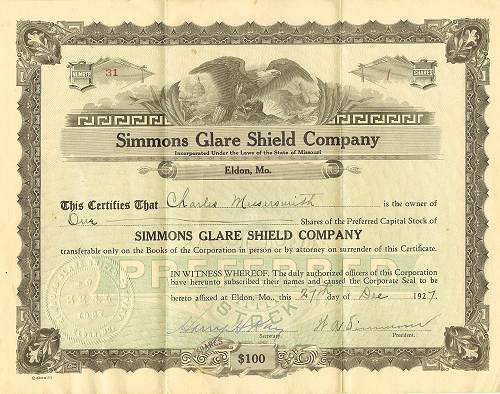
41 Glare Shield Share - Front
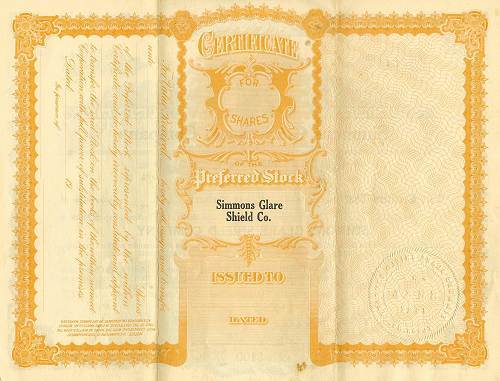
42 Glare Shield Share - Back
Recently, I came upon additional information about this company which was published in the Eldon Advertiser Centennial Edition of 1976, which has supplied much of the content for most of this week’s Progress Notes:
Automobile Accessory Originated In Eldon
Eldon Advertiser Bicentennial Edition 1976
A motoring aid believed to date from around the early 1920’s… possibly earlier…was the product of an Eldon firm. Dan Taylor found three or four of the Simmons Day-R-Nite Glare Shield, with accompanying brochures, in a box of family possessions. Simmons Glare Shield Company Inc., Eldon, W. A. Simmons, president, was listed in the brochure as “manufacturers and sole owners” of the automobile accessory whose half circle cut out always allowed drivers to have a clear unobstructed view of the road.
It was designed to protect motorists from blinding sunlight or automobile headlights. Taylor recalled that his father, Bill Taylor, had used these Simmons Glare Shields on his 1923 model Red Bird Overland.
The company’s president, W.A. Simmons, who died at his home in Eldon December 1, 1939 at the age of 76, was an insurance salesman here also.
The glare shields apparently were an extra accessory to be attached to cars before sun visors became a regular feature on the vehicles. The model for an enclosed car was priced at $4.50; a special model for open cars was less expensive at $2.50.
The brochure accompanying the Simmons Day-R-Nite Glare Shield included recommendations from local users. J.W. Bays, pastor of the First Baptist Church, was quoted as saying he found it to be “of greatest help”; E.B. Hunter, Missouri Pacific Railroad, said it made night driving enjoyable; J.W. Dooley, Rock Island Railroad, said he would not part with it.
Another glowing recommendation of Mr. Simmons, the Glare Shield Company and the Day-R-Nite Glare Shield was made by J. B. Franklin, president of Harvey Mercantile Company, who said he found the shield “indispensable for driving at night or against the bright glare of the morning and evening sun.” It was his good fortune, he said, to be among the first to purchase one of the shields.
One of the advantages stressed in company advertising was that the shield could be set instantly.
Here is a copy of an illustration from the Advertiser which offers more information about this unique original invention by Mr. Simmmons (photo 43):
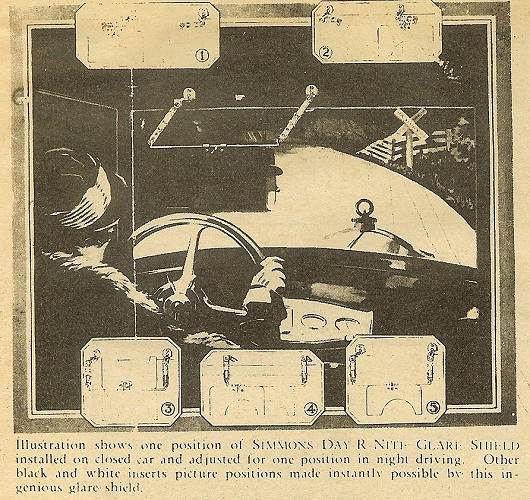
43 Glare Shield Illustration
Click image for larger view
And here is a newspaper advertisement, presumably from the Advertiser, which was published during the time the device was for sale (photo 44):
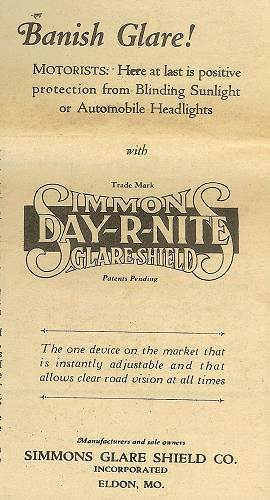
44 Glare Shield Advertisement
Click image for larger view
Unfortunately, for reasons not completely known at this time, the company was dissolved and not much more is known about it.
That’s all for this week.
 Joe Pryor
Previous article links are in a dropdown menu at the top of all of the pages.
|

